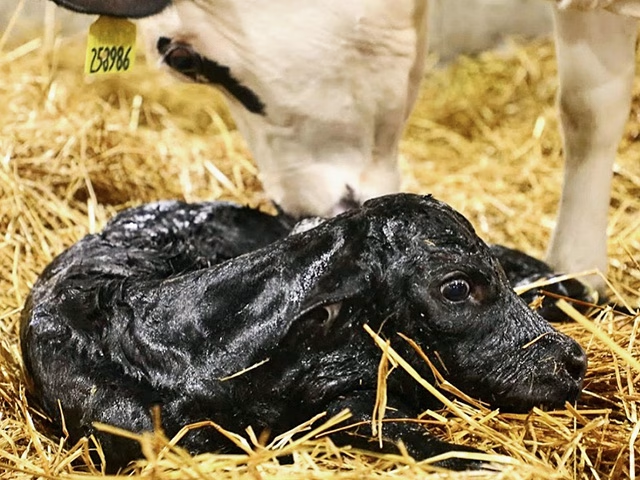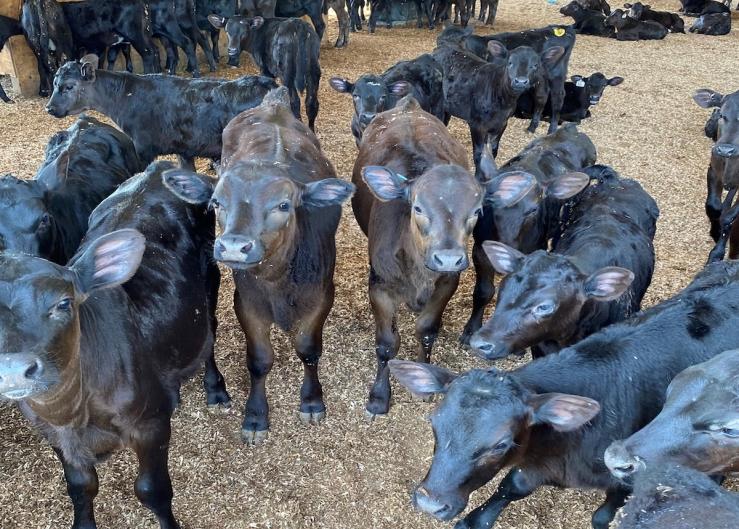Why are Italian dairy farmers doubling down on beef bull inseminations? Discover how Belgian Blue is leading the trend and its implications for the industry.
Summary: Between 2016 and 2023, the use of beef bulls in insemination of dairy cattle in Italy has grown significantly, with over 20% of inseminations in 2023 using a beef bull. This trend is driven by changing market needs and consumer preferences, with traditional procedures prioritizing milk output over meat quality. The Belgian Blue Bull is the most popular breed for crossbreeding operations, accounting for 84% of all beef bull inseminations. This breed’s genetic inclination for muscular hypertrophy, improved meat quality, and higher economic returns aligns with the Italian market’s desire for lean meat cuts. Dairy producers must match breeding procedures with customer expectations to maximize profits. Heifers represent future potential in dairy production, making it crucial for farmers to choose high-quality dairy bulls to ensure better future milk performance.
- The proportion of dairy cattle inseminations involving beef bulls doubled from just under 10% in 2016 to around 20% in 2023.
- In 2023, 430,000 out of 2.2 million inseminations involved a beef bull.
- The Belgian Blue breed dominates crossbreeding efforts, accounting for 84% of these inseminations, while Angus bulls come in second at 6.3%.
- Italians’ preference for lean beef means that crossbreeds like Angus x Holstein are less popular due to the marbling in the meat.
- Older cows are more likely to be inseminated with beef bulls, with the practice becoming significantly more common after multiple lactations.
- In 2023, approximately 40% of fifth-calf cows were inseminated with a beef bull, up from 17% in 2016.

Between 2016 and 2023, the dairy industry in Italy witnessed a remarkable and innovative shift. The practice of using beef bulls to inseminate dairy cattle, a strategy that was once a rarity, has now become a significant trend. As detailed in a recent article in the Italian trade journal Bianca Nero, this silent revolution saw the proportion of inseminations involving beef bulls quadruple over the last seven years. In 2023, over 20% of dairy cow inseminations used a beef bull, compared to just under 10% in 2016. This groundbreaking trend reflects changing market needs and consumer preferences and sets the stage for a comprehensive exploration of its implications.
Before the Beef Bull Boom: Italy’s Traditional Dairy Insemination Practices and Their Evolution
Before 2016, the Italian dairy business had deeply ingrained traditional procedures for cow insemination. Historically, dairy cow insemination in Italy focused on bulls, recognized for improving milk output rather than meat quality. Instead of concentrating on meat features, the emphasis was maximizing milk supply and enhancing genetic traits linked with dairy production, such as udder health, fertility, and longevity.
During this time, beef bulls were used for insemination in a few cases, accounting for fewer than 10% of total inseminations. The business is almost entirely centered on pure dairy breeds such as Holstein-Friesian, which are appreciated for their excellent milk production. This conservative strategy guaranteed that the dairy cow herd was genetically focused on increasing dairy efficiency, sustaining Italy’s substantial dairy product industry, renowned for cheese variations such as Parmesan and Mozzarella.
Statistical Growth in Beef Bull Inseminations (2016-2023)
Between 2016 and 2023, the usage of beef bulls on dairy cattle in Italy increased significantly, from under 10% of all inseminations in 2016 to about 20% by 2023. This move illustrates a rising tendency to introduce beef genetics into dairy herds, altering Italy’s dairy production landscape.
The Belgian Blue Bull: Italy’s Preferred Choice for Dairy Crossbreeding
Belgian Blue bulls are the most popular in crossbreeding operations, accounting for 84% of all beef bull inseminations. The Belgian Blue breed’s supremacy may be ascribed to its long-standing reputation for producing calves with superb muscling. This feature precisely matches the Italian market’s desire for lean meat cuts. Dairy producers benefit from this breed’s genetic inclination for muscular hypertrophy, improving meat quality and higher economic returns.
In sharp contrast, Angus bulls, which account for a substantially lower 6.3 percent proportion, are employed less often. The fundamental reason for this divergence is that different customer preferences drive the Italian beef industry. While Angus steak is world-renowned for its exceptional marbling (intramuscular fat distributed throughout the meat), the Italian taste prefers leaner cuts. The marbling introduced by Angus Genetics does not appeal to local preferences. Therefore, Italian dairy producers have a limited choice for Angus x Holstein crossbreeds.
The significant disparity in the use rates of these breeds underscores the pivotal role of market demand and consumer preferences in shaping breeding strategies. As dairy producers strive to maximize profits by adapting to market trends, the Belgian Blue emerges as the ideal cattle breed for insemination in Italy’s dairy industry. This emphasis on consumer preferences guides breeding decisions. It fosters a connection between the industry and its consumers, making the audience feel integral to its decision-making process.
Why Italian Consumers’ Taste for Lean Beef Shapes Dairy Farming Practices
While the worldwide taste for marbled meat has expanded, notably with the advent of Wagyu and Angus beef in gourmet markets, Italian consumers retain a specific gastronomic predilection that has far-reaching ramifications for breeding decisions. Italians often choose leaner cuts of meat in regional cuisines with reduced fat content. As a result, the Angus x Holstein crossbreed, despite its potential for increased marbling, is less popular among Italian dairy producers.
Understanding that customer preferences drive breeding tactics is critical. Marbling, the intramuscular fat that gives a rich, buttery texture, is only sometimes popular in Italy. Dishes like ‘Bistecca alla Fiorentina’ and other traditional Italian beef dishes call for lean meat, which has a distinct texture and cooking characteristic than marbled meat.
This predilection influences farmers’ decisions when choosing bulls for insemination. Belgian Blue, known for producing lean yet tasty meat, dominates the crossbreeding chart, accounting for 84% of all inseminations. Angus bulls, which may typically provide advantages in meat output, account for just 6.3 percent, owing to the marbling problem.
The economic implications of this trend are clear: dairy producers must align their breeding strategies with customer expectations to maximize profits. The ongoing preference of Italian consumers for lean beef supports the industry’s reliance on breeds like the Belgian Blue, ensuring that the final product meets market demands. This dynamic underscores the delicate balance between breeding choices and customer tastes, highlighting the profound connection between agricultural practices and culinary traditions. The shift to beef bull insemination meets consumer preferences and promises increased economic returns, painting an optimistic picture of the industry’s future.
Why Older Cows Are the Prime Candidates for Beef Bull Inseminations: Unpacking the Trend
This data analysis shows that beef bull inseminations are infrequent in heifers but considerably rise with the number of lactations. This tendency may be ascribed to several critical variables related to dairy production’s economic and biological aspects.
For starters, heifers represent future potential in a dairy herd. Thus, farmers must choose high genetic merit dairy bulls to guarantee the offspring have better milking skills. Their genetic composition is crucial in laying the groundwork for future output, thus the reluctance to employ beef bulls at this early stage. Conversely, Older cows may be less valuable in future milk production after several lactations. As a result, producers can afford to emphasize meat quality and quantity, making beef bull inseminations significantly more acceptable.
Another influence is the biological makeup of dairy cows. Heifers and younger cows need more careful reproductive control. However, employing beef bulls, which may produce bigger calves, may cause calving issues and raise health concerns. These hazards are reduced in older cows with a proven maturity and calving history, making beef bull insemination a safer and more realistic choice.
Furthermore, economically, using beef bulls in older cows is consistent with a planned lifetime strategy. Dairy producers may maximize their resources by concentrating dairy genetic features on younger, future generations while capitalizing on the increased meat value of beef-cross offspring in older cows. This approach diversifies revenue streams by combining dairy production with beef sales, a popular paradigm in today’s agricultural industry.
The growing use of beef bulls in cows with many lactations has significant ramifications for dairy farming methods. This is a segment-centric strategy in which each age group within the herd is handled to optimize specific outputs. This demands customized herd management tactics that use precise genetic planning and modern reproductive technology. Such techniques eventually offer increased economic sustainability and productivity for Italy’s dairy sector, indicating an emerging paradigm that combines tradition and innovation.
Future Trends in Dairy Crossbreeding: From Genetic Precision to Sustainable Practices
Beef bulls for dairy cow inseminations in Italy will likely continue rising, affected by various variables ranging from technical developments to evolving market needs. One possible trend is the increased accuracy of genetic selection methods. Genetic markers and genomic technology help farmers better judge which bulls to utilize, maximizing attributes like growth rate, feed efficiency, and carcass quality. This accuracy may assist in satisfying market needs more successfully, ensuring that the beef produced is consistent with customer tastes.
The market demand for lean meat, mainly from breeds like Belgian Blue, is expected to stay robust. However, when global culinary preferences alter, and new dietary trends arise, marbled meats like Angus may regain favor, particularly if marketing efforts and consumer education change views of their advantages. This might result in a more diverse approach to crossbreeding, with farms balancing bulls to respond to customer preferences.
Furthermore, advances in reproductive technology, such as sexed sperm and in vitro fertilization, might be crucial. Such technologies enable the production of more acceptable kids while maintaining high fertility rates and lowering expenses. This would primarily assist older cows, who have previously been found to be excellent candidates for beef bull inseminations, by increasing each insemination treatment’s efficiency and success rate.
Environmental concerns and sustainability trends are expected to impact future behaviors. With a growing focus on lowering the carbon impact of agricultural activities, there may be a drive for more productive and ecologically friendly breeds. This might lead to a preference for bulls, contributing to higher feed conversion ratios and reduced methane emissions, aligning dairy beef operations with overall sustainability objectives.
Overall, the future scenario of beef bull inseminations in Italy looks to be changing rapidly, owing to genetic advancements, market adjustments, and sustainability concerns. Engaging actively with these changes will be critical for dairy producers who want to stay competitive and responsive to customer expectations and environmental obligations.
The Bottom Line
The transformational change in dairy insemination trends in Italy, characterized by a considerable increase in the use of beef bulls, has not only reshaped the genetic landscape but also catered to market desires for leaner meats. Between 2016 and 2023, the number of beef bull inseminations doubled. Belgian Blue bulls were widely adopted, indicating a deliberate shift toward improving meat quality and production efficiency. The increased use of beef bulls in older cows demonstrates a tactical strategy to enhance dairy cattle lifetime and output. As Italy continues to innovate in dairy production, crossbreeding tactics will be critical to improving genetic accuracy and increasing agricultural sustainability. Finally, this dairy farming revolution proactively responds to market needs, safeguarding the Italian dairy industry’s long-term viability.
 Download “The Ultimate Dairy Breeders Guide to Beef on Dairy Integration” Now!
Download “The Ultimate Dairy Breeders Guide to Beef on Dairy Integration” Now!
Are you eager to discover the benefits of integrating beef genetics into your dairy herd? “The Ultimate Dairy Breeders Guide to Beef on Dairy Integration” is your key to enhancing productivity and profitability. This guide is explicitly designed for progressive dairy breeders, from choosing the best beef breeds for dairy integration to advanced genetic selection tips. Get practical management practices to elevate your breeding program. Understand the use of proven beef sires, from selection to offspring performance. Gain actionable insights through expert advice and real-world case studies. Learn about marketing, financial planning, and market assessment to maximize profitability. Dive into the world of beef-on-dairy integration. Leverage the latest genetic tools and technologies to enhance your livestock quality. By the end of this guide, you’ll make informed decisions, boost farm efficiency, and effectively diversify your business. Embark on this journey with us and unlock the full potential of your dairy herd with beef-on-dairy integration. Get Started!














